


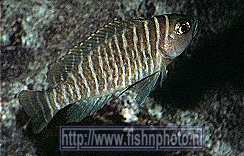
![]() Neolamperologus
similis.
Neolamperologus
similis.
Neolamprologus multifasciatus ![]()
![]() Lamprologus callipterus
Lamprologus callipterus
![]() Neolamprologus caudopunctatus
Neolamprologus caudopunctatus
Telmatochromis bricardi.![]()
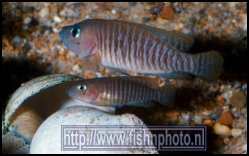
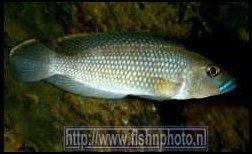
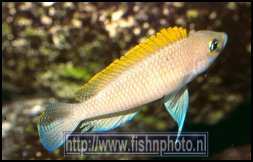
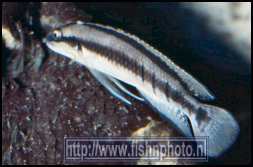
   | ||
| Incidental
shell dwelling cichlids | ||
 |
|
|
|
|
|
|
|
The two species with a zebra pattern on this page, Neolamprologus similis (BUSCHER 1992) and Neolamprologus multifasciatus (BOULENGER, 1906) are extremely suitable and especial interesting aquarium animals. They aren't real shell-dwellers in that way tat they origin from the steppingstone zone from the sandy bottom to to the lower rubble zone. They often live in large social groups in empty snail shells that are often found there, but if there are no shells available they move into cracks in the rocks. With both specimen the occupied snail cemetery is defended by all the members of the extended family together. The young fishes already set themselves the task of bringing up the even younger ones. That makes the animals tremendous productive. Who wants to get a great deal of enjoyment out of these animals would do good to take a spacious aquarium and put in it a bottom of more than average thickness. Painting in advance the glass bottom of the aquarium in a color that resemble the bottom material Perhaps you can also glue with fiberglass paste a layer of sand on the bottom. Indefatigable diggers and the will not rest before all the bottom materials under and between the shells has been eliminated. The view on the bare glass bottom is anything but lovely and moreover the animals seem to be impeded by their mirror image. Neolamprologus callipterus has been seen in relation to this evolution as a species in which the development to shell dweller has not been completed for 100%. Only the females of this species fit in a snail shell where as the males that, with their 5 inches can grow three times as large. For making themselves sure of the needed shelter and prevent rivalry struggles, they gather themselves in groups of several dozens of specimen. In that way they traverse the sand region and the intermediate region and rob everything that comes upon their way. They don't hesitate |
to
assault the offspring of predators that are far bigger as they are themselves.
They don't mind that there are killed many specimen in their own group. The animals
that remain after about a year when they became nearly grown up and re able to
drag off snail shells, settle down themselves to the reproduction.
One male animal namely
drags together
from several places
that often are far away a
series of snail shells. Also the houses that are inhabited by females for a long
time. In this way he finally guards as much as l 50 snail shells inhabited by
half a dozen females. In this gathering of snail shells other cichlids are tolerated
as well : Neolamprologus caudopunctatus and Altolamprologus compressiceps.
The territorial male mostly is half a meter above the center of the gathering
snail that nearly always find shelter against stones in the rubble region. The
distance between the territorial is at least 50 meters. The female are on a short
distance before their houses to disappear in it at the slightest danger. Remarkable
with it is that the inhabited shells do contain eggs and larvae ( Staeck 2003)
but in the whole colony there are not to be found free swimming juveniles. Also
these must be and
grow up somewhere else.
One of the many unsolved matters that scientist encounter studying the great African
rift lakes and that make research of devolution there so interesting. So
Neolamprologus callipterus is bounded to snail shells during a certain
stage of life, that is during the reproduction, bound to snail shells. Farther
on this page |